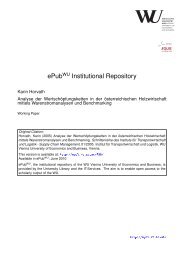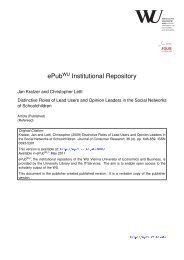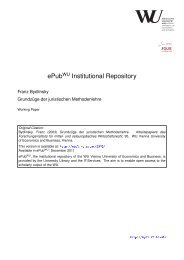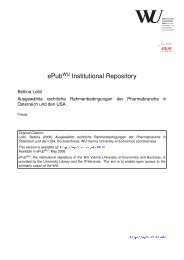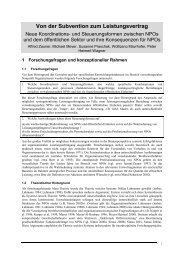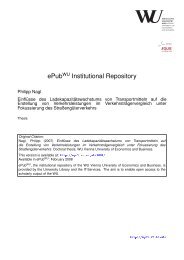ePub Institutional Repository
ePub Institutional Repository
ePub Institutional Repository
Sie wollen auch ein ePaper? Erhöhen Sie die Reichweite Ihrer Titel.
YUMPU macht aus Druck-PDFs automatisch weboptimierte ePaper, die Google liebt.
tung wird also nicht weltweit und über alle Marktsegmente hinweg gleich hoch sein.<br />
Hersteller aus dem Premiumsegment haben es tendenziell leichter, BTO Strategien zu<br />
verwirklichen, da deren Kunden, aufgrund des Strebens nach Individualität und Prestige,<br />
eher gewillt sind, höhere Preise und Wartezeiten in Kauf zu nehmen. Volumenhersteller<br />
in den mittleren Marksegmenten hingegen stehen vor dem Problem hohe Variantenvielfalt<br />
zu relativ geringen Kosten anzubieten. BTO könnte hier v.a. aufgrund der<br />
Reduktion der Lagerkosten das richtige Konzept sein. Dennoch stellt sich in diesem<br />
Segment die Frage, ob die Kunden bereit sind die höheren Kosten an sich (aufgrund<br />
des Wegfalls von Preisnachlässe und Effizienzverlusten) zu tragen bzw. ob die Kostenreduktion<br />
durch die Lagerminimierung in vollem Ausmaß an die Kunden weiter gegeben<br />
werden kann.<br />
Nach regionalen Gesichtspunkten stehen Hersteller im nordamerikanischen Markt einem<br />
größeren Problem bei der Verwirklichung von BTO gegenüber. Die Kunden sind<br />
dort in aller Regel an die sofortige Mitnahme des Neuwagens vom Hof des Händlers<br />
gewöhnt. Lediglich Europa (v.a. Mitteleuropa) zeichnet sich durch eine höhere Wartebereitschaft<br />
der Kunden aus, was einen Vorteil bei der Verwirklichung von BTO Strategien<br />
darstellt. Dennoch scheint es möglich, mit einer angemessenen Reduktion der<br />
OTD Zeit (auf ca. zwei Wochen) alle Märkte mit BTO zu bedienen. Die Verkürzung der<br />
OTD Zeit bildet also eine zentrale Voraussetzung zur Realisierung von BTO.<br />
7. Zusammenfassung in englischer Sprache (Abstract)<br />
Implementing Build to Order (BTO) strategies instead of usual Build to Stock have the<br />
potential of sorting out some individual problems of the automotive industry (e.g. high<br />
stock of finished goods). BTO reconnects the customer to the Supply Chain by focusing<br />
on him/her and making him/her to the starting point of the production process. Consequently<br />
some objectives like stock reduction as well as an increase of market shares<br />
and profits are linked with BTO.<br />
However, some requirements and preconditions have to be fulfilled to realize BTO<br />
strategies. First of all flexibility across processes, products and volume have to be assured.<br />
Therefore actions and strategies like Direct Order Booking, integration of suppliers<br />
and 3 rd party logistics, platforms and modular design could be adopted. Furthermore,<br />
it’s necessary to take measures to reduce the Order to Delivery (OTD) time generally<br />
and the time of information flow, which currently accounts for more then 85% of<br />
the delay in the production and planning process, specially. Promoting IT along the<br />
whole Supply Chain, might be the key to success in this case.<br />
Finally it should be noted that BTO could not be the overall solution for the whole<br />
automotive industry. It will only be applicable if some circumstances are satisfied.<br />
Therefore the premium segment (customers going for individuality and prestige) as well<br />
as the European market (customers with relatively high willingness to wait) are the<br />
possible fields of implementing BTO in the near future.<br />
78





